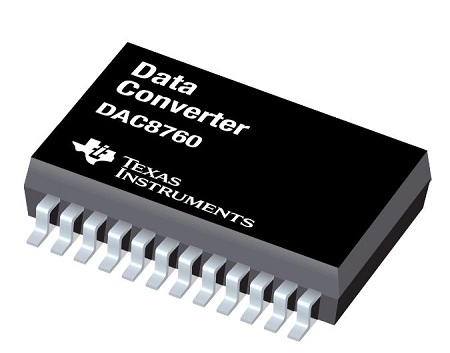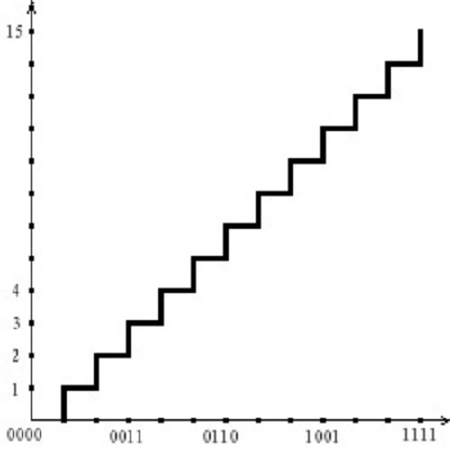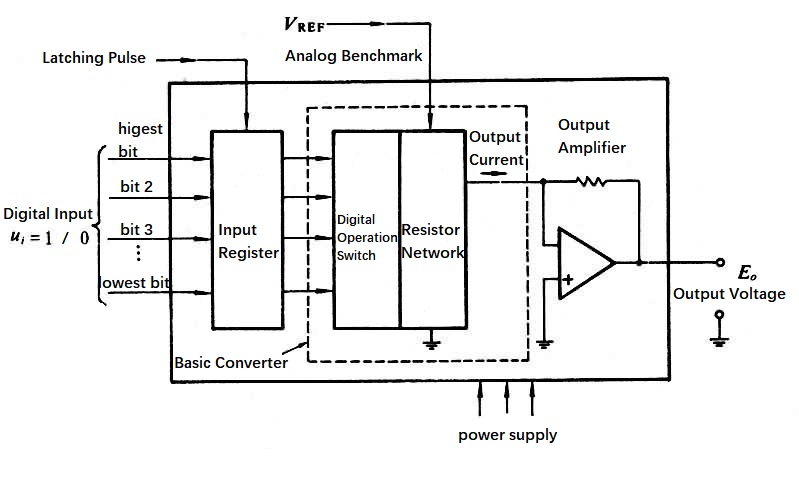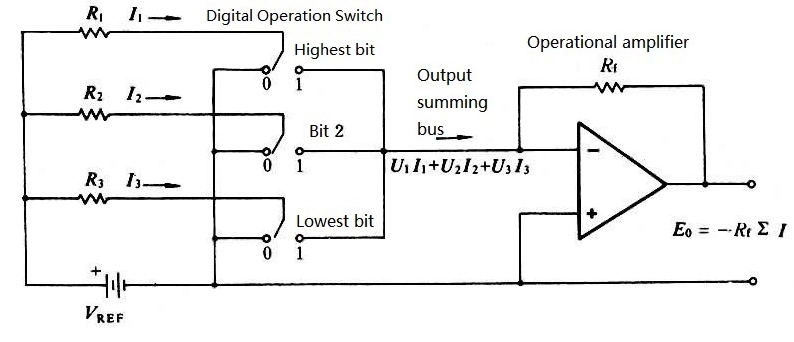What is a digital to analog converter?
A digital to analog converter, abbreviated as a D/A converter or DAC, is a device that converts digital quantities into analog quantities. The D/A converter basically consists of four parts, namely a weighted resistance network, an operational amplifier, a reference power supply, and an analog switch. Analog to digital converters usually require the use of digital to analog converters. An analog-to-digital converter, or A/D converter, or ADC, is a device that converts continuous analog signals into discrete digital signals.
1、 Composition and characteristics
The digital to analog converter consists of digital registers, analog electronic switches, decoding networks, summation amplifiers, and a reference voltage source (or constant current source). The current value is then summed by the operational amplifier and converted into a voltage value.

TI digital to analog converter DAC8760
According to bit weighted networks, different types of DACs can be formed, such as weighted resistance network DACs, R-2R inverted T resistance network DACs, and single value current network DACs.
The conversion accuracy of a weighted resistor network DAC depends on the reference voltage VREF, the accuracy of analog electronic switches, operational amplifiers, and the value of each weighted resistor. Its disadvantage is that the resistance value of each weighted resistor is different. When the number of digits is large, the difference in resistance values is significant, making it difficult to ensure accuracy, especially for the production of integrated circuits. Therefore, this circuit is rarely used alone in integrated DACs
The R-2R inverted T-shaped resistor network DAC consists of several identical R and 2R network components. Each part corresponds to an input bit. The R-2R inverted T-type resistor network DAC is one of the DACs that operates faster and is commonly used. Compared with weighted resistance networks, it only has two resistance values, R and 2R, thus overcoming the drawbacks of multiple weighted resistance values and large differences in resistance values.
On the other hand, a current type DAC switches a constant current source into a resistor network. The internal resistance of a constant current source is large, equivalent to an open circuit, so together with electronic switches, the impact on its conversion accuracy is relatively small. Due to the fact that most electronic switches are unsaturated ECL switching circuits, this DAC can achieve high conversion accuracy and high-speed conversion.
2、 Conversion principle
A numerical quantity is represented by a code that combines numbers. For title codes, each code has a certain weight. In order to convert digital quantities into analog quantities, each 1-bit code must be converted into corresponding analog quantities based on its bit weight, and then these analog quantities are added to obtain the total analog quantity proportional to the digital quantity, in order to achieve digital to analog conversion. This is the basic principle behind constructing a digital to analog converter.
The following figure shows the corresponding relationship between the 4-bit binary digital quantity and the analog quantity of the output voltage after D/A conversion. The figure also shows that the voltage values converted from two adjacent numbers are discontinuous, and the voltage difference between the two is determined by the value of the bit weight represented by the lowest code bit. It is the smallest amount of information that can be distinguished, which is what we call the amount of information represented by 1 LSB (least significant bit). The maximum voltage output value (absolute value) corresponding to the maximum input digital quantity is represented by FSR (full scale).

Figure 1 Correspondence between input digital quantity and output voltage of da converter
The D/A converter consists of a digital register, an analog electronic switch circuit, a decoding network, a summing circuit, and a reference voltage. The digital quantity is input in serial or parallel mode and stored in a digital register. The digital register outputs each digit to control the analog electronic switch of the corresponding bit, causing the digital 1 bit to generate a current value proportional to its weighted value on the bit weighted network. Then, the summing circuit adds the various weighted values to obtain the analog quantity corresponding to the digital quantity.
3、 Performance indicato
The main characteristics of digital to analog converters include the following.
resolution
The ratio of the minimum output voltage (only the lowest significant bit of the corresponding input digital quantity is "1") to the maximum output voltage (all significant bits of the corresponding input digital quantity are "1"). For example, the resolution of an N-bit D/A converter is 1/(2 ^ N-1). In practice, the resolution size is also represented by the number of digits of the input digital quantity.
linear
The linearity of analog-to-digital conversion is represented by the magnitude of nonlinear error. Define the deviation of ideal input output characteristics as a percentage of full scale output ratio as nonlinear error.
Conversion accuracy
The conversion accuracy of a D/a converter is related to the structure of the integrated chip and the configuration of the interface circuit of the D/a converter. If other D/A conversion errors are not considered, the conversion accuracy of D/A is the size of the resolution. Therefore, in order to obtain high-precision D/A conversion results, it is necessary to ensure that a D/A converter with sufficient resolution is selected first. In addition, the accuracy of D/A conversion is related to the configuration of external circuits. When external circuit equipment or power supply errors are large, it can cause significant D/a conversion errors. When these errors exceed a certain level, D/a conversion will generate errors.
In the D/A conversion process, the main factors that affect the conversion accuracy are detuning error, gain error, nonlinear error, and differential nonlinear error.
Conversion speed
The conversion speed is usually determined by the establishment time. The input suddenly changes from full 0 to full 1 until the output voltage stabilizes at FSR ± ½ LSB range (or the range specified by FSR ± x% FSR). This is called the setting time, which is the maximum response time of the DAC, and therefore it is used to measure conversion speed.
4、 Conversion method
Parallel analog-to-digital conversion

Figure 2 Structure of a typical parallel analog-to-digital converter
There are two conversion methods for analog-to-digital conversion: parallel analog-to-digital conversion and serial analog-to-digital conversion. Figure 2 shows the structure of a typical parallel analog-to-digital converter. The digital operation switch and resistor network in the dashed box are the basic components. The device in the figure generates a weighted current or voltage with reference value based scores by simulating the reference voltage and resistance trapezoidal network. A set of switches controlled by digital inputs determines which current or voltage phases are applied to form an output. Weight "is the value represented by each bit of a binary number. For example, for a three digit binary number "111", the "weight" of the first digit on the right is 20/23=1/8; The second number is 21/23=1/4; The third number is 22/23=1/2, and so on.

Figure 3 Basic Circuit of a Three Digit Analog Converter
Figure 3 shows the basic circuit of this three bit digital to analog converter. The reference voltage VREF generates binary weighted currents in R1, R2, and R3, and the current passes through the switch. When the value of the bit is "0", it is connected to ground; When the value of the bit is "1", it is connected to the output summation bus. The sum of several currents is fed back through the resistor Rf to generate an output voltage. The polarity of the voltage is opposite to the reference quantity. Each change of 1 in the input digital quantity will only result in a change of 1/23=1/8 in the output relative quantity, which is called the resolution of the analog-to-digital converter. The higher the number of digits, the higher the resolution and the higher the accuracy of the conversion. The digital to analog converters used in industrial automatic control systems are mostly 10 and 12 bits, with conversion accuracy ranging from 0.5% to 0.1%.
Serial analog-to-digital conversion
Serial analog-to-digital conversion is the process of converting a digital quantity into a sequence of pulses, where each pulse is equivalent to a unit of digital quantity, and then converting each pulse into a unit of analog quantity. Add all unit analog quantities to obtain an analog output proportional to the digital quantity, thereby achieving the conversion of digital and analog quantities.
With the rapid development and popularization of digital technology, in order to improve the performance indicators of the system, digital computer technology is widely used in signal processing. Due to the fact that the actual objects of the system are often analog signals (such as temperature, pressure, displacement, images, etc.), in order for computers or digital instruments to recognize and process these signals, it is necessary to first convert these analog signals into digital signals. The digital output of computers after analysis and processing often needs to be converted into corresponding analog signals in order to be accepted by the executing agency. This requires a circuit that serves as a bridge between analog and digital signals - an analog-to-digital and analog-to-digital converter.
The circuit that converts analog signals into digital signals is called an analog-to-digital converter (referred to as an A/D converter or ADC). A/D converters and D/A converters have become indispensable interface circuits in computer systems.
In order to ensure the accuracy of system processing results, A/D converters and D/A converters must have sufficient conversion accuracy; In order to achieve real-time control and detection of rapidly changing signals, A/D and D/A converters also require high conversion speeds. Conversion accuracy and speed are important technical indicators for A/D and D/A converters. With the development of integrated technology, many single-chip and hybrid integrated A/D and D/A converters have been developed and produced, which have increasingly advanced technical specifications.
-
Whatsapp

